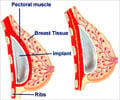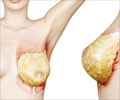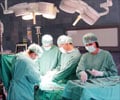What is Breast Augmentation?
Breast augmentation surgery or augmentation mammoplasty is a procedure done to enlarge breast size, or alter its shape and texture. During this operation, implants or a mobilised fatty flap maybe positioned beneath the breast tissue or chest muscles.
Anatomy of Breast
It is helpful to know briefly about the normal breast anatomy to understand the details of the breast augmentation surgery better.
The breasts are basically made up of fatty tissue and these are situated between the pectoralis muscle below and the skin above.
They generally start to develop between the ages of 9 to 14 due to hormonal changes occurring during puberty.
The milk producing glands are arranged in lobules with each breast having around 15 to 20 lobules each.
In addition, the breast contains ducts that carry the milk from the glands to the nipple, fatty tissue and some muscles that open and close the nipple.
The breasts are supported through suspensory ligaments of Cooper and these are attached to the muscle tissue called pectoralis major fascia. Thee ligaments run throughout the breast tissue from the chest wall muscle underneath and attach above to just beneath the skin. Since they are not taut, they permit the natural motion of the breast. With age, these ligaments relax leading to sagging of the breasts.
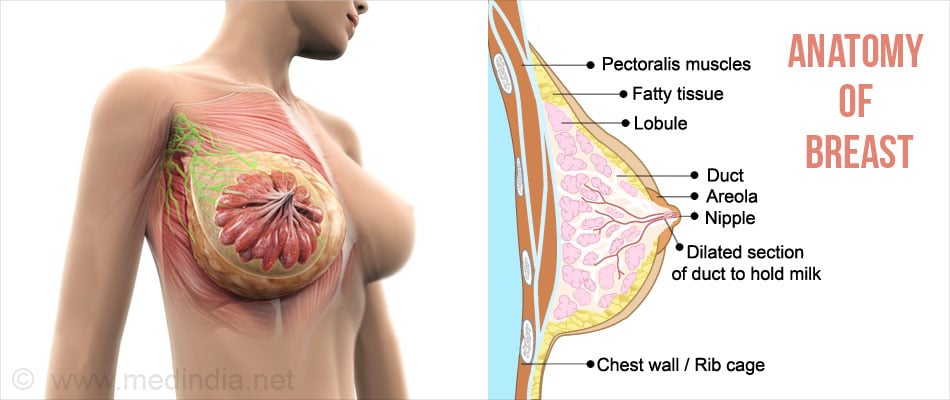
Types of Breast Augmentation
Broadly, two types of Breast Augmentation procedures can be described, namely
- Breast Implant Surgery - using implants to augment their size
- Non- implant Fat Graft Mammoplasty
Augmentation using Implants
Breast implants are classified according to the filler material used. Currently, the two most popular devices are saline devices and silicone devices.
The saline implant is made up of a silicon shell that is filled with sterile saline solution during surgery.
The silicon device has a silicon shell pre filled with silicone gel that is positioned within the breast during surgery.
Saline breast implants:
The implant is filled with sterile saline. It gives an uniform size, shape and feel to the breasts.
These are FDA approved and can be used in women 18 years and older.
If the shell breaks, it will collapse and the saline will leak out. However, it will be naturally absorbed and eliminated by the body.
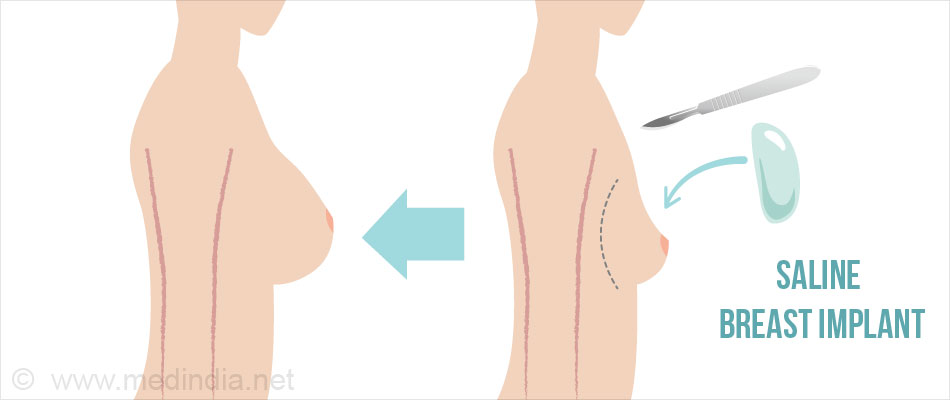
Silicone breast implants
These implants are filled with silicone gel and resemble normal breast tissue in their feel. If the implant leaks, it will not collapse as saline implants do.
Regular follow-ups are needed to monitor the status and position of the implants.
Gummy bear implants
They are also referred to as form stable implants. These implants contain silicone gel that is thicker than normal. The consistency is firmer and they maintain the shape even if the implant breaks.
They are shaped instead of round, with the top tapered and projecting downwards. If the implant rotates due to an accident, the breast shape will appear unusual. These implants require a longer skin incision.
Round breast implants
Unlike form stable implants, these implants are round and breast shape is retained even if the implant should rotate.
Smooth breast implant
These implants move within the shell and may provide more natural movement. They have a very soft feel.
Textured implants
These implants form scar tissue and reduce risk of movement of the implant within the breast and alteration of its shape.
Non-implant Fat Graft Mammoplasty
It is referred to as autologous fat grafting. This procedure involves removing fat (liposuction) from other parts of the body and injecting it into the breast tissue.
This is done in women who want a relatively smaller increase in their breast size and wish to obtain natural results.
Indications for Breast Augmentation
- Primary reconstruction - replacement of breast tissue damaged by trauma, cancer or mal-development
- Revision surgery - to revise or correct a prior breast reconstruction surgery
- Primary augmentation - to enlarge the size or alter the shape and feel of the breast for aesthetic purposes
This may be done to improve self-confidence, correction reduction of breast size following pregnancy or inequality in size.
Breast Lift or Mastopexy
It should be noted that in persons in whom there is an extreme degree of sagging or ptosis of the breasts, augmentation procedure alone may not be successful. In such women a breast lift or mastopexy is also performed in addition.
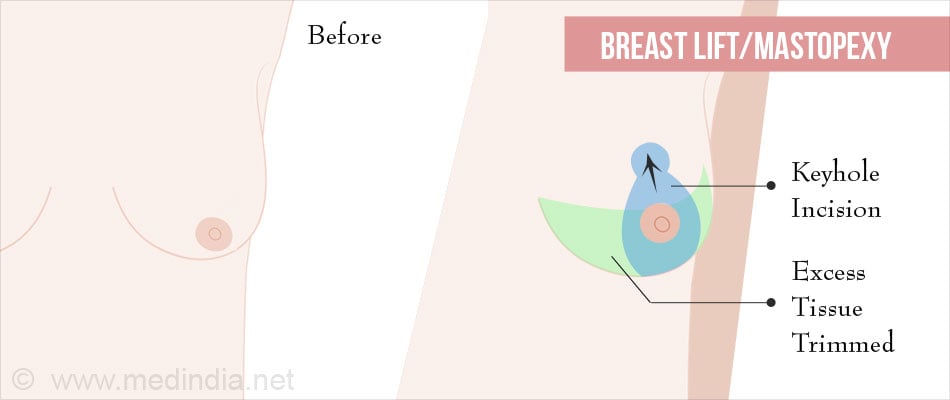
Before the Procedure - Preparation
- Breast augmentation surgeries are performed by plastic surgeons skilled in breast reconstruction. It is important to choose a doctor with established credentials and someone you can trust.
- They may be performed either in an established outpatient center or in a hospital.
- The ultimate goal of undergoing breast augmentation surgery is to improve the woman’s natural proportions creating a more symmetrical, aesthetically appealing breast profile. The exact procedure is modified according to the woman’s desire and needs.
- The woman needs to discuss her expectations from surgery with the doctor. Issues such as desired breast size, shape and texture have to be discussed at length.
- In addition, they should inform about associated medical conditions and medications that they may be using.
- A thorough examination of the breasts, their size, shape and feel, position of nipple and areola will be carried out. Detailed measurements and photographs will be taken for comparison post-surgery.
- While it is natural to feel anxious or apprehensive, it is important to understand what the procedure entails and the woman should not hesitate to clear her apprehensions and fears with the doctor.
- Before surgery certain medications may need to be stopped like aspirin for a few days to reduce the risk of bleeding during surgery.
- Basic investigations such as urine examination, blood hemoglobin, group, and chest x-ray will be required before surgery.
- Once admitted to the hospital for surgery, the patient has to take nothing orally for a minimum of six hours before being taken up for the surgery.
- The surgery is performed under strictly sterile conditions.
- The surgeon will evaluate the breasts and discuss the various options and implants available and recommend a particular course of treatment suited to the woman. Risks of the procedure and potential complications will also be discussed.

Breast Augmentation Procedure
The procedure involves the following steps namely
Anesthesia
The surgery will be performed under anesthesia to sedate the patient and provide pain relief. A choice of intravenous or general anesthesia will be recommended based on the individual patient.
Skin Incision
Skin incision will be made in inconspicuous areas to reduce the visibility of scars. The type of incision will vary depending on the implant material, desired size of breast required and of course the individual preferences of the patient and surgeon.
Insertion and Placing the Implants
Following the incision, the breast implant is inserted into a pocket created beneath the muscle (pectoralis muscle) or directly under the breast tissue.
Closing the Incisions
Once the implants are in place, the breast tissue is closed in layers followed by closure of the skin incision.
Seeing the Results
Once the patient recovers from anesthesia, the results of the surgery can be seen and appreciated.
Recovery after Surgery
Most patients have an uneventful period following surgery and resume normal activities within a few weeks. It is nevertheless important to know what to expect during the recovery period and prepare for it.
- The patient may be permitted to go home within a few hours.
- She may need to wear a compression bandage or sports bra to support the breasts while they heal.
- Some soreness and swelling can be expected in the area for a few weeks.
- Medications for pain relief and to reduce risk of infection will be prescribed.

- The patient may be advised a few days of reduced activity immediately following the surgery.
- Exercise and normal activity can be resumed as per the advice of the surgeon.
- If non-absorbable stiches have been used for the skin incision, and or drainage tubes have been placed near the breasts, a follow-up appointment is necessary to remove the same.
- The patient should contact the doctor immediately in case of
- Fever,
- Redness
- or Soreness over the breast. It may be the sign of an infection.
Complications and Limitations
Complications of Breast Implants
- Early complications include post-operative bleeding and hematoma formation, pain or altered sensation, seroma or fluid collection, wound dehiscence, infection and excessive scarring.
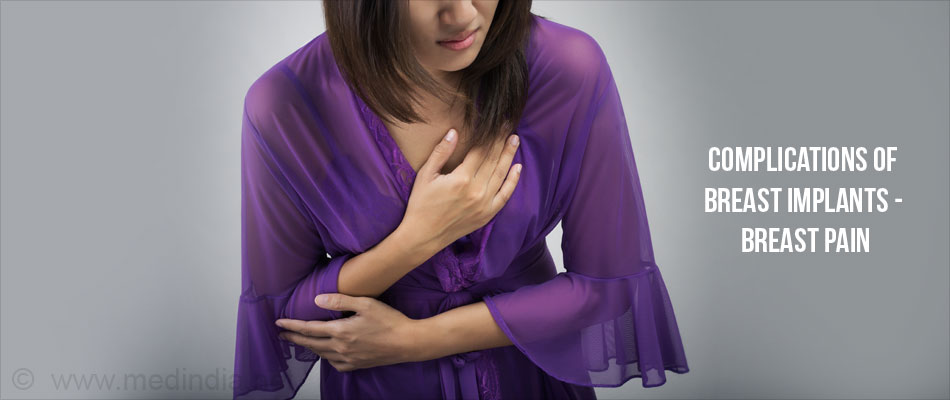
- Delayed complications include asymmetry in breast sizes, visible wrinkling, breakage of implant, capsular contracture, and Uniboob (symmastia) where the natural cleavage plane between the breasts is interrupted and the two implants are in contact with each other.
Complications and Limitations of Autologous Fat Grafting
Fat necrosis, calcification and cystic change are complications that may occur in the grafted fat tissue.
The increase in size and fullness that can be achieved with implants is not possible with autologous fat grafting. Even with plentiful tissue to harvest, women achieved only a maximum of one brassiere cup increase in breast size in one session.
In such cases, a combination of fat grafting and breast implant may be an alternative and give the desired result.
General Limitations of Breast Augmentation
In general breast augmentation surgery improves a woman’s self-esteem and confidence. However, one should have realistic expectations. People looking for perfection will be disappointed.
Also, the average life of an implant is around 10 years. Pregnancy, breastfeeding and aging process will also alter the appearance of the implant and may need corrective surgery.
Complications occurring following the augmentation may also need revision or repeat surgery.
Health tips
- Weigh the pros and cons before deciding to undergo augmentation surgery.
- Choose an experienced plastic surgeon you are comfortable with, and can trust.



